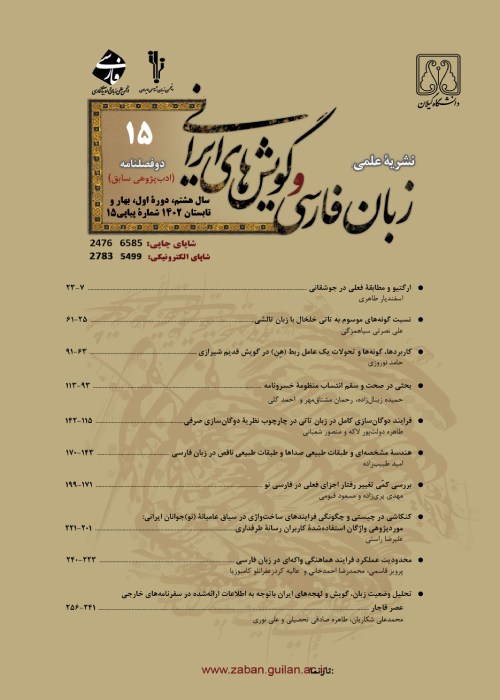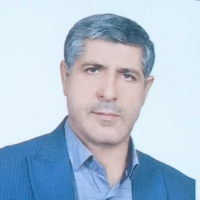Analysis of the Status of Iranian languages, Dialects and Accents According to the Information Presentated in the Foreign Travelogues of the Qajar Era
Travelogues are considered as valid and important documents. The travel writers of the Qajar period, who were mostly European and were mainly among the prominent scientific and literary characters of their time, have provided valuable information, with an in-depth look at the history of Iranian literature, Iranian languages, dialects and accents, Persian script, libraries, scientific and artistic centers, and the cultural and social situation of Iran. The explanation of the state of languages and dialects in the Qajar period is one of the issues, that is investigated in this essay, in an analytical-descriptive way. Findings show that the travel writers have discussed about the common languages and dialects of the Qajar period and different regions that have a pure Persian accent, and have mentioned the “ear-splitting” and “ear-scratching” dialects of Iran, as well as, the dialects that have ancient roots. According to their report, the Persian language is on the margins in the Qajar court and the Turkish language is common; but during the period of Naser al-Din Shah and after him, the Persian language became popular in the court. Turkish language is the second language, based on the number of speakers, and Mazandarani dialect is the most powerful dialect in attracting immigrant speakers. Non-Iranian languages, Georgian, Armenian, Hebrew, Nestorian and their geographical range are mentioned in the works in question. The roots of some Persian words have been identified, and a number of Persian and European words have been compared.
The literary situation of each country can be examined from different sides. Among all, this issue can be examined from view points of travel writers. The number of travelogues and travelogue writing is closely related to the civilization of each society, and it shows the cultural, social, economic and literary development of a nation. The Qajar period is the golden time of foreign travel writing about Iran. Most of the European travel writers who came to Iran in this era were among the prominent scientific and literary people of their time, and they traveled to the country with relatively high knowledge about Iranian culture, civilization and literature. Among these, we can mention scientists and travel writers such as Edward Brown, Karlaserna, Deulafova, Pollock, Kenneth Gobineau, George Curzon, and dozens of other travel writers.
One of the major advantages of foreign travelogues is the scientific attention of travelogues to the category of Persian language. Travel writers have provided valuable information in the fields of phonetics, accentology and dialectology, and etymology of Iranian words and in comparing them with words of European languages, aesthetics of dialects and accents, and knowledge of Persian grammar. In this research, we are looking for answers to these questions: “How are Iranian languages, dialects and accents reflected in foreign travelogues?” “In Qajar era, what are the non-Iranian languages spoken in Iran, and what is their geographical domain? What is the geographical domain of the Persian language and Iranian dialects and accents in the Qajar era?
Foreign travelogues are precious treasures of comprehensive information about countries and regions. The points in the travelogues can shed light on the obscure and dark parts of Persian literature. Their documented and tangible reports on the status of Persian and other languages of Iran in Qajar era are very important, and can be used as a basis for extensive research. In this essay, the foreign travelogues of the Qajar era, during 1794 to 1925 have been examined and analyzed with a qualitative approach, and from an integrative view point. We have had both a historical and descriptive look to linguistic contents presented in these travelogues. In these works, valuable and comprehensive information has been provided, not only about Persian but also about other Iranian languages, dialects, and accents spoken in the Qajar period, in different regions of Iran. Foreign travel writers have also paid attention to the etymology of some Persian words during their stay in Iran, and in addition to discussing the non-Iranian languages used by Iranians, they have also paid attention to the influences of Persian on European languages. However, their analyzes are not without problems and sometimes they even give incorrect opinions. Of course, it should be added that even these mistakes and forgetfulnesses, at least in the topics related to language, linguistics, and dialectology, do not reduce the precision and nobility of their opinions and the scientific value of their words, since their accurate and scholarly words are much more than their false and misleading words.
The research method is analytical-descriptive, and mainly relies on library readings, reviewing documents, and intertextual evidences and analysis, and comparison of data. In this research the forign travelogues of Qajar Periods, during 1794-1925, has been investigated.
The most important results obtained are: the second official language of Iran after Persian has been Turkish, in Qajar era; the common language in the Iranian court during the Qajar era has been Turkish, which, of course, is replaced by Persian from the period of Naser al-Din Shah; the languages spoken in Iran during the Safavid and Qajar periods are described as “blik: baligh” for Persian, “shiash, arrogant” for Turlish, “Cheshik, eloquent” for Arabic, and “Ilyati” for the language of the villagers; Laki and Qohrudi are dialects trlated to the Old Persian language; the regions of Khorasan, Shahrood, shores of the Caspian Sea (Mazandaran, Gilan), Kurdish speaking regions, Lorestan, Bakhtiari, Kermanshah, Shushtar and Dezful have a pure Persian accent; Brahui in Sistan is mixed with Indian language; the highest dialectal variety is in Mazandan; Zoroastrian dialect is more prevalent in central parts of the country (Yazd and Kerman); Zargari dialect can be a kind of secret lcode and is not a unique dialect not-related to Iranian dialects; no information has been reported about the languages and dialects of the Iranian shores of the Persian Gulf.
travelogue , Qajar era , language , Dialect , accent
- حق عضویت دریافتی صرف حمایت از نشریات عضو و نگهداری، تکمیل و توسعه مگیران میشود.
- پرداخت حق اشتراک و دانلود مقالات اجازه بازنشر آن در سایر رسانههای چاپی و دیجیتال را به کاربر نمیدهد.



